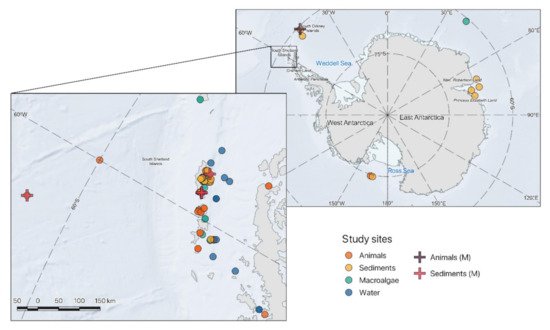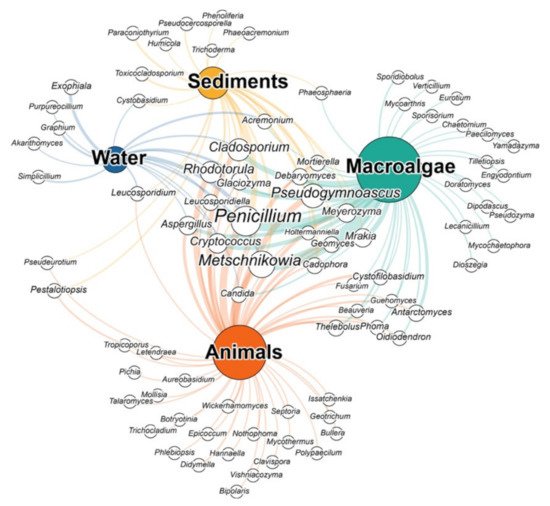Despite the harsh conditions, fungi are ubiquitously present in Antarctic ecosystems. The key to fungal success can be due to the vast array of specialized molecules, which allowed their colonization in almost every habitat of our Planet. In Antarctic marine environments, the fungal specific adaptions to low temperatures lead to the production of structurally novel enzymes and secondary metabolites that provide competitive advantages over other microorganisms. The bioprospecting of Antarctic fungi for new bioactive compounds and enzymes is important not only for elucidating their ecological role but also useful for developing blue biotechnologies.
- marine fungi
- mycology
- fungal diversity
- Antarctica
- bioprospecting
- biotechnology
- psychrophiles
- cold-adapted enzymes
- industrial applications
- blue biotechnologies
1. Background
2. Fungal Diversity and Ecology in Antarctic Marine Environments

2.1. Fungal Diversity
2.1.1. Fungi in Antarctic Marine Environment

2.1.2. Fungi Associated with Antarctic Macroalgae and Animals
2.2. Contribution of Fungi to Ecological Processes in Antarctic Marine Ecosystems
3. Biotechnological Potential of Fungi Inhabiting Marine Antarctic Environments
3.1. Antarctic Marine Fungi: Promising Candidates for Bioprospecting
| Fungal Taxa | Product | Bioactivity | Source | Ref. |
|---|---|---|---|---|
| Penicillium citrinum OUCMDZ4136 | 2,4-Dihydroxy-3,5,6-trimethylbenzoic acid; Citreorosein; Pinselin; Citrinin; Dihydrocitrinone; Pennicitrinone A; Quinolactacin A1 | Cytotoxic activities against MCF-7, A549, K562 cell lines | Antarctic krill Euphasia superba | [83] |
| Penicillium citreonigrum SP-6 | Diketopiperazine, phenols | Inhibitory activity against HCT116 cancer cell line | Marine sediment, Great Wall Station | [165] |
| Penicillium crustosum HDN153086 | Diketopiperazine | Cytotoxic activities against K562 cell line | Marine sediment, Pridz Bay | [61] |
| Penicillium crustosum PRB-2 | Penilactone A | NF-KB inhibitory activities of HCT-8, Bel-7402, BGC-823, A549 and A2780 tumor cell lines | Deep-sea sediment, Prydz Bay | [46] |
| Penicillium glabrum SF-7123 | Citromycetin derivative, neuchromenin; myxotrichin C, deoxyfunicone; | Anti-inflammatory; tyrosine phosphatase 1B inhibition | Marine sediment, Ross Sea | [50] |
| Penicillium granulatum MCCC 3A00475 | Spirograterpene A | Antiallergic effect on immunoglobulin E (IgE)-mediated rat mast RBL-2H3 cells | Deep-sea sediment, Prydz Bay | [52] |
| Penicillium sp. PR19N-1 | Chlorinated eremophilane sesquiterpenes, eremofortine C, eremophilane-type sesquiterpenes, eremophilane-type lactam | Cytotoxic activity against HL-60 and A549 cancer cell lines | Deep-sea sediment, Prydz Bay | [51,163] |
| Penicillium sp. S-1–18 | Butanolide A, guignarderemophilane F, xylarenone A | Butanolide: inhibitory activity against tyrosine phosphatase 1B; xylarenone A: antitumor activity against HeLa and HepG2 cells and growth-inhibitory effects against pathogenic microbes | Sea-bed sediment | [60,166] |
| Penicillium sp. UFMGCB 6034 and UFMGCB 6120 | Aromatic compounds | Antifungal and trypanocidal activities | Macroalgae: Palmaria decipiens and Monostroma hariotii | [66] |
| Pseudogymnoascus sp. | Pseudogymnoascin A, B, C, 3-nitroasterric acid; Geomycins B, C | Antibacterial and antifungal activities | Sponge genus Hymeniacidon | [167,168] |
| Trichoderma asperellum | Asperelines A-F, peptaibols | Not assayed | Marine sediment, Penguin Island | [56,169] |
3.2. Antarctic Fungi as Novel Source of Cold-Active Enzymes
| Enzyme | Reaction | Fungi | Source of (Isolate) Sample | Applications/Potential Uses | Ref. |
|---|---|---|---|---|---|
| Carragenase (EC 3.2.1.83) | Hydrolysis of 1,4-β-linkages between galactose 4-sulfate and 3,6-anhydro-galactose to produce kappa-carrageenans | Pseudogymnoascus sp. UFMGCB 10054 | Macroalga: Iridaea cordata, | Biomedical field, textile industry, bioethanol production, and detergent additive | [69] |
| Cellulase (EC 3.2.1.4) |
Cellulose hydrolysis into glucose | Cystofilobasidium infirmominiatum 071209-E8-C1-liblev; Metschnikowia australis, Rhodotorula glacialis; Candida spencermartinsiae, Leucosporidiella creatinivora, Leucosporidium scottii | Marine sponge: Tedania; marine sediments; seawater | Food industry, animal feed, beer and wine, textile and laundry, pulp and paper industry, agriculture, biofuel, pharmaceutical industries, and waste management | [45,80] |
| Chitinase (EC 3.2.1.14) |
Cleavage of glycosidic linkages in chitin and chitodextrins generating chitooligosaccharides | Lecanicillium muscarium CCFEE-5003; Glaciozyma antarctica PI12 | Shrimp wastes; seawater | Cosmetic, pharmaceutic fields, fermentation research, and biomedicine | [45,198,199,200,201,202] |
| Endo-β-1,3(4)-glucanase (EC 3.2.1.6) |
Endohydrolysis of (1→3)- or (1→4)-linkages in β-D-glucans | Glaciozyma antarctica PI12 | Seawater | Brewing and animal, feed-stuff industry, biofuel production, and pharmaceuticals | [202,203,204] |
| Esterase (EC 3.1.1.1) |
Hydrolysis of short acyl-chain soluble esters | Cryptococcus victoriae, Metschnikowia australis, Rhodotorula glacialis, Leucosporidium scottii, Leucosporidiella creatinivora; Glaciozyma antarctica | Marine sediments; seawater, sea ice | Paper bleaching, bioremediation, degradation, and removal of xenobiotics and toxic compounds | [45,205] |
| Invertase (EC 3.2.1.26) |
Hydrolysis of the terminal non-reducing β-fructofuranoside residue in sucrose, raffinose and related β-D-fructofuranosides | Glaciozyma antarctica 17 (formerly Leucosporidium antarcticum) | Seawater | Beverage, confectionary, bakery, invert sugar, high fructose syrup, artificial honey, calf feed, food for honeybees | [38] |
| Laccase (EC 1.10.3.2) |
Oxidation of phenolic compound like lignin | Cadophora malorum A2B, Cadophora malorum AS2A, Cadophora luteo-olivacea P1 | Marine sediments | Biosensors, microfuel and bioelectrocatalysis, food, pharmaceutic, cosmetic, pulp and paper, textile industries, and bioremediation | [206] |
| Lignin peroxidase (EC 1.11.1.14) |
Oxidative breakdown of lignin | Cadophora malorum M7, Cadophora sp. OB-4B | Marine sediments | Pulp and paper, cosmetics (treatment of hyperpigmentation, and skin-lightening through melanin oxidation), textile, bioremediation (degradation of azo, heterocyclic, reactive, and polymeric dyes, xenobiotic, and pesticides), and bioethanol production | [206] |
| Lipase (EC 3.1.1.3) |
Hydrolysis of long-chain triacylglycerol substances with the formation of an alcohol and a carboxylic acid | Leucosporidium scottii L117, Metschnikowia sp. CRM1589; Mrakia blollopis SK-4; Cystofilobasidium infirmominiatum 071209-E8-C1-IIa-lev and isolate 131209-E2A-C1-II-lev; Metschnikowia australis 131209-E3-C1-(GPY)-lev and isolate 131209-E2A-C4-II-lev; Rhodotorula pinicola 071209-E4-C9-lev; Candida zeylanoides, Cryptococcus victoriae, Leucosporidiella creatinivora, Leucosporidium scottii, Candida sake, Candida spencermartinsiae | Marine sediments; Algal mat in sediment; marine sponges: Tedania, Hymeniacidon, Dendrilla; Seawater | Food, beverage, detergent, biofuel production, animal feed, textiles, leather, paper processing, and cosmetic industry | [45,47,48,207,208,209] |
| L-asparaginase (EC 3.5.1.1) | Degradation of asparagine into ammonia and aspartate | Cosmospora sp 0B4B, Cosmospora sp 0B1B, Cosmospora sp 0B2, Geomyces sp. S2B |
Marine sediments | Food industry and medical applications as anti-cancer, antimicrobial, infectious diseases, autoimmune diseases | [206] |
| Pectinase (EC 3.2.1.15) |
Hydrolysis of polysaccharides to produce pectate and other galacturonans | Geomyces sp. strain F09-T3-2, Pseudogymnoascus sp., Cladosporium sp. F09-T12-1, Cryptococcus victoriae, Leucosporidiella muscorum, Metschnikowia australis, Rhodotorula glacialis; Leucosporidiella creatinivora, Leucosporidium scottii | Marine sponges; marine sediments; Seawater | Food and textile industry, coffee and tea fermentation, wine processing, oil extraction, vegetable and fruit processing industry for juice clarification, color, and yield enhancer. Applications in paper and pulp making, recycling of wastepaper, pretreatment of pectic wastewaters, and retting of plant fibers | [45,82,210] |
| Phytase (EC 3.1.3.26) |
Hydrolysis of phytate to produce phosphorylated myo-inositol derivatives | Rhodotorula mucilaginosa JMUY14 | Deep-sea sediments | Food and feed industry, pharmaceutical use as neuro protective agents, anti-inflammatory, antioxidant and anti-cancer agents | [211] |
| Protease (EC 3.4) |
Cleavage of peptide bonds | Rhodotorula mucilaginosa L7; Pseudogymnoascus sp. CRM1533, Leucosporidiella muscorum; Leucosporidiella sp. 131209-E2A-C3-II-lev, Leucosporidiella creatinivora 071209-E8-C4-II-lev; Rhodotorula glacialis; Leucosporidiella creatinivora, Leucosporidium scottii | Marine macroalgae; marine sediments; marine sponges: Tedania, Hymeniacidon; Seawater | Food, feed, pharmacology (anticancer and antihemolytic activity) cosmetic (keratin-based preparation) industries, cleaning processes (e. g. detergent additive), waste management | [45,47,48,212,213] |
| Protease (Subtilase) (EC 3.4.21) |
Cleavage of peptide bonds | Glaciozyma antarctica 17 (formerly Leucosporidium antarcticum) | Sub-glacial waters (depth of 200 m) | Food and beverage industries | [214,215] |
| Transglutami-nase (EC 2.3.2.13) |
Acyl transfer reaction between gamma-carboxyamide groups of glutamine residues in proteins and various primary amines | Penicillium chrysogenum | Marine macroalga Gigartinas kosttbergii | Food, pharmaceutical, leather, textile, biotechnology industry, biomedical research | [216] |
| Xylanase (EC 3.2.1.8) |
Hydrolysis of the main chain of xylan to oligosaccharides, which in turn are degraded to xylose | Cladosporium sp.; Penicillium sp. E2B Penicillium sp. N5, Penicillium sp. E2-1 | Marine sponge; marine sediments | Food (bread making), feed, paper and pulp industries, and also used to increase the sugar recovery from agricultural residues for biofuel production | [206,217,218] |
| α-amylase (EC 3.2.1.1) |
Cleavage of α-1,4-glycosidic linkages within starch molecules, which generate smaller polymers of glucose units | Glaciozyma antarctica PII12 (formerly Leucosporidium antarcticum); Cystofilobasidium infirmominiatum 071209-E8-C1-IIa-lev, 131209-E2A-C1-II-lev, 131209-E2A-C5-II-lev and isolate 071209-E8-C1-IIb-lev; Metschnikowia australis 071209-E8-C3-II-lev and isolate 071209-E8-C1-II-lev; Leucosporidiella sp. 131209-E2A-C3-II-lev | Seawater; marine sponges: Tedania, Hymeniacidon | Pharmaceutical and chemical industry; employed as additives in processed food, in detergents for cold washing, in waste-water treatment, in bioremediation in cold climates, and in molecular biology protocols | [80,202,219] |
| β-agarase (EC 3.2.1.81) |
Hydrolysis of beta-(1–>4) linkages of agarose to produce oligosaccharides | Penicillium sp., Cladosporium sp. 2, Penicillium sp., Pseudogymnoascus sp. UFMGCB 10054, Doratomyces sp. |
Macroalgae: Ascoseira mirabilis, Georgiella confluens, Iridaea cordata, Palmaria decipiens | Food, cosmetic, medical industries, and as a tool enzyme for biological, physiological, and cytological studies | [69] |
| β-galactosidase (EC 3.2.1.23) | Hydrolysis of lactose into its constituent monosaccharides | Tausonia pullulans 17-1 (formerly Guehomyces pullulans) | Marine sediments | Food, biofuel, and agricultural industries; surfactant production | [220] |
3.3. Emerging Bioprospecting Methods: Pitfalls and Future Perspectives
This entry is adapted from the peer-reviewed paper 10.3390/jof7050391
